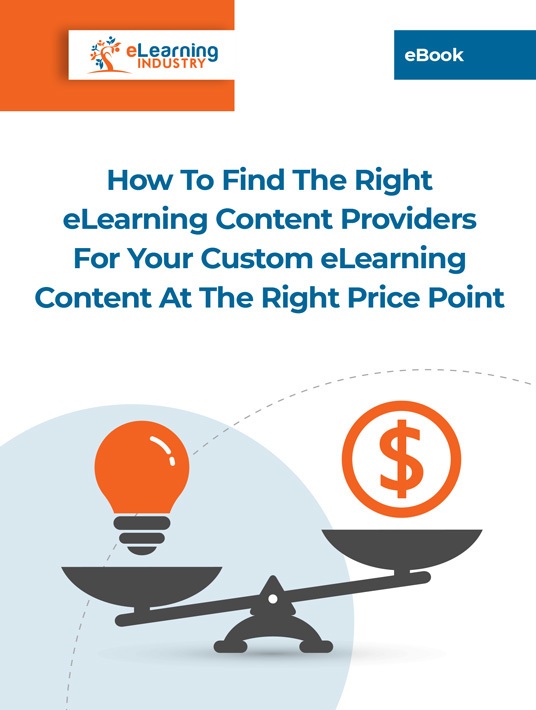Tips To Calculate A Spot-On Budget For Rapid eLearning Content Development
Many organizations choose rapid eLearning content development because it doesn't put a strain on their L&D expense sheet. That said, it still costs money, not to mention time and energy, even if you're reusing archived resources or already own a rapid eLearning authoring tool. There's still payroll and content upkeep to consider, among other things. Fortunately, this budgeting checklist can help you create an accurate rapid eLearning design budget for your team. It even includes those pesky hidden fees that everyone seems to forget about.

Checklist To Calculate The Budget For Rapid eLearning Content Development
Online training costs can quickly spiral out of control and force you to dip into other areas of your budget. Simple formatting issues or unclear online training objectives may cause your expenses to skyrocket. However, eLearning outsourcing adds another element of surprise. How do you know how much to allocate? What are the fees involved? Is there a way to tally up all the tasks before you hire an eLearning vendor for employee online training? What will you handle in-house, and is it more cost-effective to outsource the job to external experts? Follow these tips to estimate your eLearning content development costs accurately and avoid overspending.
1. Take Stock Of Existing Assets
A big part of rapid eLearning design is reusing what you already have, whether it's a rapid authoring tool with an amazing asset library or resources in your online training repository. Thus, you need to take stock of everything before creating your budget. This helps prevent redundant content and allows you to zero in on relevant materials. You also need to take it a step further and organize content by training topics, objectives, or skill gaps. That way, you have everything in one centralized location, and it's easy to find reusable assets because they're all tagged or sectioned off within the database.
In short, an online training resource inventory helps you calculate the eLearning content development costs more accurately because you know what you're working with. For example, identify videos or images the eLearning vendor can repurpose to reduce fees. But an in-depth evaluation also allows you to pinpoint gaps you've overlooked. Gaps that you need to consider when calculating costs to get the best online training ROI. Maybe you're missing branching scenarios or simulations that foster real-world application. Or you've completely ignored a skill that your employees need in order to improve on-the-job performance.
2. Conduct A Training Needs Analysis
Conduct a TNA for your online training program. Resources are limited, so you need to prioritize your L&D and figure out which tasks to outsource to eLearning companies. Where are the gaps? How can an eLearning vendor help you address them? What are the costs involved, and is it really worth the investment? Some eLearning vendors even offer Training Needs Analysis services to help you disclose problem areas and troubleshoot. Just be sure to clarify whether that's included in the price or if they charge additional fees—which is usually the case.
3. Set An Implementation Timeline
As a general rule, the faster the timeline, the more it's going to cost, as you typically have to hire more people or purchase pre-built assets to make up the difference. The exception is rapid eLearning content that's hyper-targeted. For instance, you only need to create a bite-size compliance training module, and you already have all the resources. It's simply a matter of compiling everything and adding a few digital elements like a pop quiz or new images. If you plan to outsource, bear in mind that tight time frames may increase your budget as the provider must move things around in their schedules and possibly bring other collaborators into the mix. But I'll talk more about outsourcing later in this post.
4. Use An Online Training Storyboard To Break It Down
This is your opportunity to map out all the online training activities, modules, and JIT support tools you need to factor into the eLearning outsourcing budget. You normally use an online training storyboard at the design stage. However, it's also a valuable tool for calculating eLearning development costs because it gives you a visual outline of everything you need to maximize employee online training benefits. For instance, you must hire a custom eLearning content provider for 5 new skill-based simulations. How much can you spend on each activity? Are there any online training resources the eLearning vendor can reuse? Are there certain aspects of the task you can tackle in-house versus outsourcing the entire corporate eLearning project?
5. Tally Team Payroll Expenses
More organizations implement a rapid eLearning content process these days because it's easier on the budget. Faster turnaround times also mean that you can stay ahead of company changes and emerging issues like new policies or compliance challenges that may impact your bottom line. However, one of the most significant expenses they overlook is payroll. It's not just compiling existing resources and putting them into a template. Consider all the prep work, curation, and revisions that go into the process. SMEs, IDs, graphic designers, content creators, and admins need time to develop meaningful rapid eLearning courses.
6. Calculate Tool Costs
Rapid eLearning authoring tools are one of the most obvious tool expenses. However, you also need an LMS to deploy and track content. Some organizations even spring for video conferencing tools to host and record live events, which gives them even more material for their rapid eLearning strategy. As such, you need to research pricing models and deployment types. For example, some vendors offer a one-time licensing fee, while others have monthly subscriptions. Other software fees to keep in mind are add-ons, upgrades, and additional asset packages like a cut-out character package or more branching scenario templates.
7. Consider Long-Term Maintenance
A common application for rapid eLearning design is training topics with quick expiration dates. For instance, you're working on permanent task protocols to streamline the sales process and improve customer satisfaction. In the meantime, employees need to know how to perform the basic steps and explore all the skills involved. Thus, a rapid eLearning module provides a quick and concise overview, then you can roll out your comprehensive course when the time is right. On the other hand, other rapid eLearning applications require ongoing maintenance. You must update content to reflect company changes and make it more relevant for modern staffers. Maintenance also applies to your rapid eLearning tools and online training archives.
8. Factor In Seat Time
Training off the clock is usually frowned upon, particularly when it's mandatory online training. Therefore, seat time is also an essential part of your rapid eLearning content development budget, even though it has nothing to do with the design process per se. You still need to calculate how much time it takes employees to complete the course and then incorporate that into your payroll expenses. Another factor to consider is the software learning curve. Some staffers are familiar with the LMS, while others need a little time to acclimate.
9. Create A Separate Outsourcing Budget
It's best to create a different budget for all your outsourcing tasks for comparison. As an example, this is how much it will cost to develop rapid eLearning content for onboarding internally, and this is how much time you should allocate for your L&D department. Then move over to the outsourcing expense sheet and determine if it's more cost-effective to hire a content provider. Separate budgets also make it easier to adjust spending and measure ROI.
There's always room for error when you tally the figures for eLearning outsourcing. Maybe you forgot to include eLearning software licensing renewals or eLearning content conversion fees. For this reason, it's best to have some leeway in your budget and host regular recap meetings. Discuss corporate eLearning project hiccups and how they've impacted your eLearning content development costs. Chat with outsourcing eLearning vendors during the corporate eLearning project to ensure the expense sheet is still accurate. Finally, always overestimate the amount you need for every milestone or design task.
10. Request eLearning Vendor Estimates
Reach out to eLearning vendors for free personalized quotes. This offers two advantages. The first is that you find eLearning companies who work within your price bracket. The second is that you can expand your eLearning development expense sheet based on their itemized breakdown. As an example, you didn't even realize that support services or eLearning software were additional fees on top of the base price. You'll be able to compare your eLearning content development costs checklist with theirs to ensure everything is accounted for.
11. Host A Team Risk Assessment Meeting
You might not know all the development hurdles, but members of your team have experienced them firsthand. Host a risk assessment meeting to get their feedback and identify hidden costs. For example, they are unable to design certain aspects of the online training course because they lack the necessary tools or know-how. Thus, you need to outsource them to the eLearning vendor and add that to your estimate. You can also set up a backup plan meeting with your eLearning outsourcing partner to prevent overspending. For instance, what will you do if the corporate eLearning project hits a snag and requires more online training resources to address emerging gaps?
Conclusion
A clear rapid eLearning content development budget sets you up for L&D success. However, you also need to re-evaluate from time to time. You may need to purchase new tools to keep up with tech changes or outsource more tasks to lighten the workload. So, pencil in a budget deep-dive every few months just to make sure you're still on track and making the most of available resources. After all, that's the main reason why you chose rapid eLearning design in the first place.








